Lawrence Livermore National Laboratory (LLNL) is a federally funded research and development center in Livermore, California, United States. Originally established in 1952, the laboratory now is sponsored by the United States Department of Energy and administered by Lawrence Livermore National Security, LLC.

Nuclear weapon designs are physical, chemical, and engineering arrangements that cause the physics package of a nuclear weapon to detonate. There are three existing basic design types:
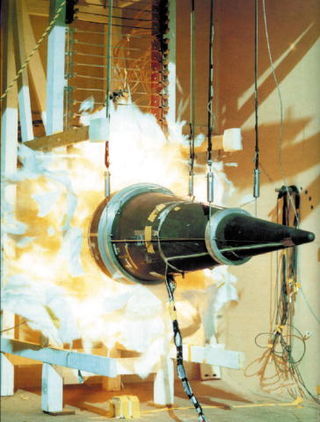
Stockpile stewardship refers to the United States program of reliability testing and maintenance of its nuclear weapons without the use of nuclear testing.

The B61 nuclear bomb is the primary thermonuclear gravity bomb in the United States Enduring Stockpile following the end of the Cold War. It is a low to intermediate-yield strategic and tactical nuclear weapon featuring a two-stage radiation implosion design.
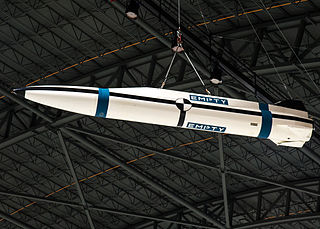
The AGM-131 SRAM II was a nuclear air-to-surface missile intended as a replacement for the AGM-69 SRAM. The solid-fueled missile was to be dropped from a B-1B Lancer, carry the W89 warhead and have a range of 400 km. However, the program was canceled by President George H. W. Bush for geopolitical reasons just as the first flight-test missile was delivered.
The W69 was a United States nuclear warhead used in the AGM-69 SRAM.
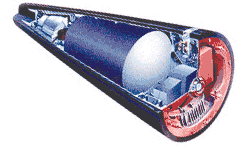
The W76 is an American thermonuclear warhead, designed for use on the UGM-96 Trident I submarine-launched ballistic missiles (SLBMs) and subsequently moved to the UGM-133 Trident II as Trident I was phased out of service. The first variant, the W76 mod 0 (W76-0) was manufactured from 1978 to 1987, and was gradually replaced by the W76 mod 1 (W76-1) between 2008 and 2018, completely replacing the Mod 0 in the active stockpile. In 2018 it was announced that some Mod 1 warheads would be converted to a new low-yield W76 mod 2 (W76-2) version. The first Mod 2 warheads were deployed in late 2019.

The W87 is an American thermonuclear missile warhead formerly deployed on the LGM-118A Peacekeeper ("MX") ICBM. 50 MX missiles were built, each carrying up to 10 W87 warheads in multiple independently targetable reentry vehicles (MIRV), and were deployed from 1986 to 2005. Starting in 2007, 250 of the W87 warheads from retired Peacekeeper missiles were retrofitted onto much older Minuteman III missiles, with one warhead per missile.

The W84 is an American thermonuclear warhead initially designed for use on the BGM-109G Gryphon Ground Launched Cruise Missile (GLCM).

The W47 was an American thermonuclear warhead used on the Polaris A-1 sub-launched ballistic missile system. Various models were in service from 1960 through the end of 1974. The warhead was developed by the Lawrence Radiation Laboratory between 1957 and 1960.

The W68 warhead was the warhead used on the UGM-73 Poseidon SLBM missile. It was developed in the late 1960s at Lawrence Livermore National Laboratory.
The Reliable Replacement Warhead (RRW) was a proposed new American nuclear warhead design and bomb family that was intended to be simple, reliable and to provide a long-lasting, low-maintenance future nuclear force for the United States. Initiated by the United States Congress in 2004, it became a centerpiece of the plans of the National Nuclear Security Administration (NNSA) to remake the nuclear weapons complex.
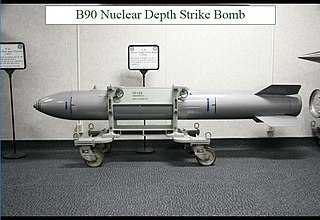
The B90 Nuclear Depth Strike Bomb (NDSB) was an American thermonuclear bomb designed at Lawrence Livermore National Labs in the mid-to-late 1980s and cancelled prior to introduction into military service due to the end of the Cold War.
The W60 was nuclear warhead developed for the United States Navy's long range Typhon LR surface-to-air missile.
Fogbank is a code name given to a secret material used in the W76, W78 and W88 nuclear warheads that are part of the United States nuclear arsenal. The process to create Fogbank was lost by 2000, when it was needed for the refurbishment of old warheads. Fogbank was then reverse engineered by the National Nuclear Security Administration (NNSA) over the better part of a decade and at the cost of tens of millions of dollars.
The National Nuclear Security Administration (NNSA) is a United States federal agency responsible for safeguarding national security through the military application of nuclear science. NNSA maintains and enhances the safety, security, and effectiveness of the U.S. nuclear weapons stockpile; works to reduce the global danger from weapons of mass destruction; provides the United States Navy with safe and effective nuclear propulsion; and responds to nuclear and radiological emergencies in the United States and abroad.
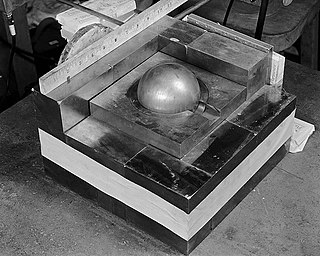
In nuclear weapon design, the pit is the core of an implosion nuclear weapon, consisting of fissile material and any neutron reflector or tamper bonded to it. Some weapons tested during the 1950s used pits made with uranium-235 alone, or as a composite with plutonium. All-plutonium pits are the smallest in diameter and have been the standard since the early 1960s. The pit is named after the hard core found in stonefruit such as peaches and apricots.

Area 27 is a division of the Nevada National Security Site. It occupies approximately 49 square miles (130 km2) in the south-central portion of the NNSS. A portion of Area 27 was originally known as Area 410.
Miriam E. John is an American engineer who is a policy advisor and former vice president of Sandia National Laboratories. She is an expert in nuclear weapons and chemical defence. In 2022, she was awarded the Lawrence Livermore National Laboratory John S. Foster, Jr. Medal and was elected Fellow of the National Academy of Engineering.













